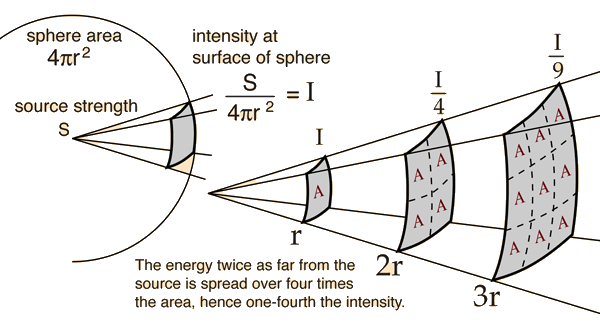- Forum
- Photography and Camera Forum
- Taking the Photo | Editing | The art of Photography!
- Beginner Photography Forum
- Is there an easy way to understand inverse square law?
Is there an easy way to understand inverse square law?
-
 Topic Author
Topic Author
- Tsoto
- Lone Wolf
-
- Nikon 5100
- Followers: 29
- Posts: 119
-
Points:
818
Post #246343
I'm completely lost and need some help understanding this. So if I double the distance between my flash and a surface that is reflecting that the light from my flash the intensity drops 1/4?
Is that how it works?
-

- KCook
- Photo Elder
-
- Canon EOS 50D and Olympus E-P5
- Followers: 1325
- Posts: 5410
-
Points:
32913
-

- John Landolfi
- Super User
-
- Nikon D3S, D7100, Sony RX10, Canon G11, F4s, F2sb, RetinaflexIV etc, etc
- Followers: 1205
- Posts: 21605
-
Points:
40394
Post #246369
Let's call
I=actual intensity of light
O=Flash output
d=distance to subject.
The law says that I=O/(d squared)
If the distance doubles to 2d, then you have to divide by (2d)squared. So
I=O/(2d)squared=O/4(d squared), So the intensity falls by a factor of 4.
If the distance trebles to 3d, then you divide by (3d)squared=9(d squared), so the intensity falls by a factor of 9.
And so on.
-

- John Landolfi
- Super User
-
- Nikon D3S, D7100, Sony RX10, Canon G11, F4s, F2sb, RetinaflexIV etc, etc
- Followers: 1205
- Posts: 21605
-
Points:
40394
Post #246449
-

- KCook
- Photo Elder
-
- Canon EOS 50D and Olympus E-P5
- Followers: 1325
- Posts: 5410
-
Points:
32913
Post #246482
www.cambridgeincolour.com/tutorials/diff...ion-photography.htm/
Kelly
-

- John Landolfi
- Super User
-
- Nikon D3S, D7100, Sony RX10, Canon G11, F4s, F2sb, RetinaflexIV etc, etc
- Followers: 1205
- Posts: 21605
-
Points:
40394
Post #246511
-

- Henry Peach
- Apprentice
-
- I currently use a 5DII or Sony Nex-3 most of the time.
- Followers: 50
- Posts: 2925
-
Points:
16
Post #247525
Tsoto wrote: So if I double the distance between my flash and a surface that is reflecting that the light from my flash the intensity drops 1/4?
Yep. 2 stops ( 1 stop is double or half the light). 1/2 x 1/2 = 1/4th.
-

- Stealthy Ninja
- Moderator
-
- Fuji X stuff and a 1DsIII for some reason
- Followers: 982
- Posts: 16300
-
Points:
6837
-

- KCook
- Photo Elder
-
- Canon EOS 50D and Olympus E-P5
- Followers: 1325
- Posts: 5410
-
Points:
32913
-

- Stealthy Ninja
- Moderator
-
- Fuji X stuff and a 1DsIII for some reason
- Followers: 982
- Posts: 16300
-
Points:
6837
-

- Brad Eckel Photography
- Newbie
- Follower: 1
- Posts: 2
-
Points:
0
Post #247719
check this site out from NASA. I have not posted on here before so it would let me do the entire link... so put the 3w's and the dot in front of it.
imagine.gsfc.nasa.gov/YBA/M31-velocity/1overR2-more.html
-

- Brad Eckel Photography
- Newbie
- Follower: 1
- Posts: 2
-
Points:
0
Post #247729
From basic math a circle uses the radius sqaured and a sqaure has two equal sides. When calculating the area of these, the area becomes larger non linearily due to the squaring of the radius or multiply of the length times the width (since L=W in a sqaure L x W = L x L = L^2 (or L sqaured). Similarly in ALL units of measure for an area for instance a room is measure in feet squared.
Light spreads out from... more or less... a single "flash" point, in straight, but not in parallel lines. Light, is a form of energy, which once the flash is activated is sent out on various angles from the flash point. This engery value does not increase or decrease, but merely gets dispersed over a larger area as it travels further away from the flash point (until it hits an object and is either absorded, reflected or refracted... another story)
In the NASA diagram, you will see each progressively larger area shades lighter as the distance increase from the from the flash point.
Note: "flash" point, can be replaced for any light source (lamp, reflector, sun etc) base princple is still the same.
-

- John Landolfi
- Super User
-
- Nikon D3S, D7100, Sony RX10, Canon G11, F4s, F2sb, RetinaflexIV etc, etc
- Followers: 1205
- Posts: 21605
-
Points:
40394
Post #247798
-

- Crammer
- Photography Hooked
-
- Nikon D810 & D90
- Followers: 139
- Posts: 942
-
Points:
7837
Post #249406
John Landolfi wrote: Let me try:
Let's call
I=actual intensity of light
O=Flash output
d=distance to subject.
The law says that I=O/(d squared)
If the distance doubles to 2d, then you have to divide by (2d)squared. So
I=O/(2d)squared=O/4(d squared), So the intensity falls by a factor of 4.
If the distance trebles to 3d, then you divide by (3d)squared=9(d squared), so the intensity falls by a factor of 9.
And so on.
-

- John Landolfi
- Super User
-
- Nikon D3S, D7100, Sony RX10, Canon G11, F4s, F2sb, RetinaflexIV etc, etc
- Followers: 1205
- Posts: 21605
-
Points:
40394
Post #249527
- Forum
- Photography and Camera Forum
- Taking the Photo | Editing | The art of Photography!
- Beginner Photography Forum
- Is there an easy way to understand inverse square law?
Latest Reviews
The Fujifilm XT5 is a 40MP mirrorless camera capable of 6.2K video at 30p. With those specs, it’s an ideal choice for photographers needing a camera to pull double duty for imaging and video.
The Canon EOS R100 is an entry-level mirrorless camera introduced in 2023. But just because it’s an entry-level camera doesn’t mean it’s a bare-bones camera. Find out why in this review!
Nikon’s retro-looking Nikon Zfc is anything but retro. Under its classic body is a host of features and amenities that make it a worthwhile compact mirrorless camera for 2024.
The Canon EOS R50 is one of the newest R-system cameras from Canon. Is it worth your money? Find out all the details you need to know in this comprehensive review.
Latest Articles
With these simple yet effective beginner photography tips, you can avoid some of the common mistakes beginners make and get improved results with your images.
Urban photography is a genre showcasing features in urban settings. You can photograph people, architecture, mass transit, and many other subjects. Learn how to do so in this guide!
The Nikon D850 might be an older DSLR, but it was ahead of its time when it debuted in 2017. That means it still has plenty of firepower to compete with today’s powerful mirrorless cameras.
The best beginner camera isn’t the same for everyone. That means having choice is of the utmost importance. In this guide, explore five excellent beginner camera options for 2024 and beyond.
Child portrait photography is a unique undertaking requiring special skills and talents to get the best results. Start mastering this photography niche with these essential tips!
The Fujifilm XT5 is a 40MP mirrorless camera capable of 6.2K video at 30p. With those specs, it’s an ideal choice for photographers needing a camera to pull double duty for imaging and video.
Using leading lines in photography helps improve the composition by drawing viewers in and leading their eye from the foreground to the background. Explore some fine examples of this in this guide!
The Insta360 has one of the best lineups of action cams and 360-degree cameras. With these Insta360 accessories, you can elevate your photography and videography game!



















